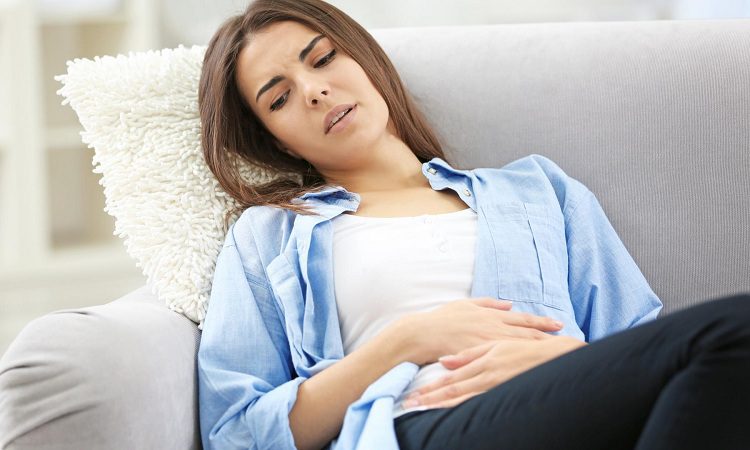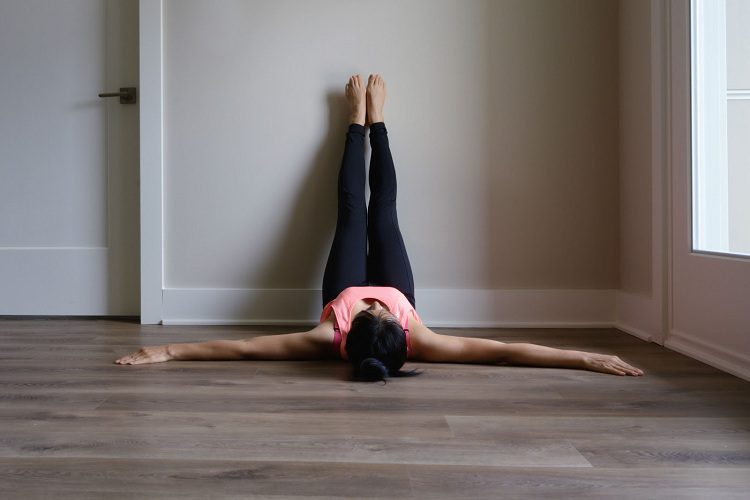Yoga is a combination of physical and mental exercises that provides so many incredible benefits for the human body, mind, and soul.
One of the most beautiful things about yoga is the fact that it is something that people of all ages can enjoy.
There are a variety of methods, strategies, and regimens that can be practiced in order to achieve a well-rounded balance of all the positives that yoga has to offer.
Another one of the amazing things that yoga can provide is the ability to study the array of different techniques, and choose specific workouts to target issues or areas of concern that need to be addressed.
Everything from depression and anxiety to physical ailments like back problems, circulation issues, and so many others can be ameliorated through strategic yoga practices.
Today we would like to discuss endometriosis in specific, and get an in-depth look into how yoga can help with the symptoms and side effects that women struggling with this condition must face.
What Is Endometriosis?

Endometriosis is a potentially painful disorder or condition that occurs in females.
It occurs when tissue that is similar to the tissue that is found on the inner lining of the uterus (known as the endometrium), grows outside of the uterus.
Endometriosis is most commonly known to affect the ovaries, fallopian tubes, and other tissues in the pelvic area, as that is where the condition manifests.
This endometrial-like tissue that grows outside of the uterus will thicken, and then break down and bleed with each menstrual cycle.
However, since the tissue does not have a way to be discharged from the body, it becomes trapped and will irritate surrounding tissues.
Endometriosis can cause severe pain, facilitate the development of cysts on the ovaries, and can also cause fertility problems to develop.
As a result, it is incredibly important for individuals that have symptoms to seek a diagnosis, and for people who have been properly diagnosed to seek treatment and find ways to healthily cope with their condition.
What Causes Endometriosis?

The actual cause of endometriosis, or the growth of tissue similar to uterus lining outside of the uterus, is not something that has been confidently identified.
However, researchers and health care workers have been studying possible causes in order to gain insight and learn how to develop treatments for the condition.
Here are some of the more common possible causes of endometriosis that have been studied and documented:
#1 Issues with menstrual cycle period flow
One of the most likely causes or contributors to the development of endometriosis is retrograde menstrual flow.
This is characterized by blood flowing backward into the pelvic area, instead of out of the vagina during menstruation.
Some of the tissue shed can, as a result of retrograde menstrual flow, end up inside the pelvis and cause endometriosis.
#2 Genetic factors
Endometriosis is something that has been identified to transcend between generations and run in family bloodlines.
As a result, it can be concluded that it is a condition that can potentially be inherited genetically by offspring.
#3 Immune system issues
An immune system that is not functioning correctly may not be able to identify and get rid of endometrial tissue that has formed and is growing outside of the uterus.
As a result, individuals with compromised or faulty immune systems have been known to be more susceptible to endometriosis.
#4 Hormones
Unusual levels and activity of estrogen is something that researchers believe may be a contributor to the development of endometriosis.
Further studies are being conducted to find out if there is a direct correlation between hormonal issues and endometriosis.
#5 Surgery
Surgeries that involve work being done in the abdominal area (Cesarean Section, Hysterectomy, etc..), can cause endometrial tissue to be accidentally picked up and transported outside of the uterus.
If this misplaced endometrial tissue is able to survive and grow, it will potentially cause the development of endometriosis.
How Can Yoga Help With Endometriosis?

Living with endometriosis is not an easy task and can significantly affect an individual’s quality of life (physical, emotional and mental well-being).
There are a number of different methods for people struggling with endometriosis to find relief and reduce the effect of the symptoms that can sometimes be quite painful and aggravating.
One strategy, in particular, is the use of yoga to provide healing benefits that will have a positive impact on endometriosis and its symptoms.
The first of these benefits involves the calmness and relaxation that come with proper yoga sessions.
Someone struggling with the effects of endometriosis can use meditation to allow themselves to relieve physical discomfort and ease the mind.
Research has actually shown that yoga sessions and the breathing techniques that are involved can contribute to alleviating chronic pain in the pelvic area of individuals with endometriosis.
Yoga styles and strategies that put emphasis on mindfulness, controlled/slow movements, and all-around longer position holding times have been recommended for endometriosis patients by women’s health specialists.
Restorative poses that are gentle and do not cause too much strain are recommended. These exercises encourage the abdominal, lower back and inner thigh, and pelvic floor muscles to soften and relax.
Best Yoga Poses For Endometriosis
Endometriosis is known to cause significant pain for individuals struggling with symptoms and effects.
There are a number of yoga poses that have been commonly used for endometriosis, in specific to help alleviate pelvic and abdominal pain.
Some individuals with endometriosis will experience little to no pain, while others will report borderline excruciating and debilitating levels of pain and discomfort.
Here are a few of the best yoga poses for endometriosis therapy and symptomatic pain relief.
Pelvic Tilts & Circles

Consistently moving the pelvis will help loosen muscle and connective tissue tension in the pelvic area, where women experiencing endometriosis symptoms are often the most tense.
Procedure
- Stand, sit on a chair or lie down somewhere comfortable.
- Keep your torso straight, take a nice breath in and rock your pelvis forward, as if you were trying to spill water from your pelvic bowl. Exhale and rock your pubic bone backward allowing your back to arch slightly. Repeat this 5 times.
- Form circles and figure eights with your hips and continue to breathe in synchronicity with the movements. Do circles and figure eights 5 times each in one direction and then switch directions.
Supported Reclining Butterfly Pose

The reclining butterfly pose will help to deeply relax muscles in the pelvic region and inner thighs.
It is also known to contribute to the loosening ligaments, tendons, and other soft tissues that are found around the hip joints.
It will also open up the chest, which can become tense in people experiencing chronic pain.
Procedure
- Lie on a sturdy bed or on a yoga mat. Put a pillow or some other bolstering object under your back and head in order to open your chest. Keep your knees bent and your feet flat on the floor. Take a few breaths in this position in order to begin the relaxation process.
- Bring the soles of your feet together. Inhale and then exhale and let your knees gently separate, keeping the soles of your feet connected. Support your knees with pillows, blankets or other solid objects.
- With each breath in, feel your pelvic region and lower abdomen fill up with air. With each breath out, envision these areas on your body softening and opening. Remain in this pose for around 10 minutes. To disengage, remove the support from beneath your knees first and then return your feet to the floor. Slowly roll onto your side and then come up to a seated position.
Legs Up Wall Pose

This pose will help to restore and relax the nervous system, while also allowing the pelvic floor to soften.
Procedure
- Lie on your back on a yoga mat or something soft on the floor next to a full-sized wall. Tuck your buttocks in as close to the wall as you can, touching it if possible.
- Place your legs up against the wall, until the backs of your legs rest against it or get as close as possible. If you would like some extra support, place a pillow, folded blanket, or other soft objects under your sacrum. If you need to bend your knees for comfort that is acceptable.
- Next, relax your arms by your side. Close your eyes and breathe gently. Make sure to pay close attention to the sensation of your lower back relaxing and softening into the ground. Remain in this pose for two to three minutes. To disengage, bend your knees, roll onto your side slowly, and then sit up.
Other Ways To Help With Endometriosis

Yoga is a great way to help individuals who are suffering from endometriosis and the associated symptoms to find relief.
There are however a number of other strategies to help these people deal with the pain and discomfort that comes with the condition.
Here are a few helpful strategies that can, alongside yoga, be beneficial for people living with endometriosis.
- Heat Therapy: Heat therapy is a great way to deal with the pain associated with endometriosis. There are a number of ways to implement heat therapy including warm baths and investing in a quality heat pad for regular therapeutic use.
- Stay Hydrated: Staying hydrated may seem obvious or easy to do, but it is incredibly important to reduce bloating, cramping and related pain. Some people may think they have been drinking enough water, but are often unknowingly dehydrated.
- TENS Machine: A transcutaneous electrical nerve stimulation (TENS) machine is designed to emit vibrations into the body that can reduce pain and help relax the muscles. Consult a physical therapist to try a test run and book sessions, or purchase a home unit online.
Conclusion
Yoga is something that people of all ages can enjoy and provides the potential for us to harness the incredible mind, body, and soul benefits that it offers.
Yoga can help people who are struggling with physical conditions to alleviate the pain and discomfort associated with their conditions.
One of the most incredible aspects is that specific methods and strategies can be studied and used in order to target the pain associated with specific disorders or illnesses.
We have discussed in detail how yoga can be used to help individuals struggling with endometriosis.
We also provided a brief description of the way that endometriosis presents itself from an anatomical perspective, as well as what factors researchers and specialists believe cause it to manifest.
From there we went on to discuss how practicing yoga can be beneficial for individuals living with endometriosis and looking for ways to reduce pain and discomfort.
We provided a few of our favorite pelvic, lower back, and abdominal muscle targeting yoga poses for pain relief, alongside a brief step-by-step execution guide.
Finally, we outlined a few other strategies and it is truly amazing what practicing yoga can do for humans.
Harnessing this potential and using yoga as a form of therapy that can be implemented as a form of pain and symptom relief for illnesses is incredibly important.
Take the information and advice provided in this article and apply it to your lives, and the lives of the people around you who can reap the benefits.
Resources:

